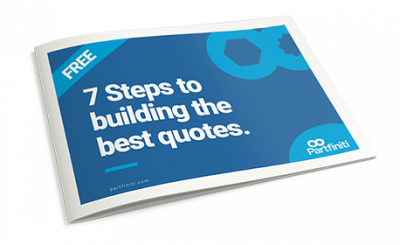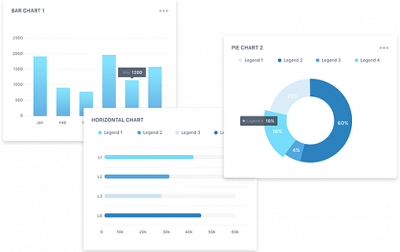-
- Dec 01, 2020
- 4 years
The High Cost of Slow Quotes
You’ve been there. Working for months to land a new customer. If you could just get a crack at one order to show them what you can do, they will see how good your products are and what a great company you are to work with. They finally give you a chance to give them a price on something, and then, it happens …
The quote process stalls. Your customer keeps asking when they can expect to receive it. They’re considering other offers. It takes three days to send it.

What happened? You know you can trust your team. They have been working with you for years, are well trained and work hard. They care about the customer and want the company to succeed.
Then why did it take 3 days to send a quote for something that seemed standard and simple?
I like to call is “Death by Too Many P’s.” Take a deeper look at the long quoting process that your team followed to get that seemingly simple quote done and you will likely find the extra time was caused by these four P’s:
- Too Many Platforms
- Too Many Players
- Too Many Parts
- Too Many Prices
Without proper consideration and preparation, the combination of these four P’s will most likely lead to an unacceptable TTQ (Time To Quote). Let’s break them down a bit further and see where the issue with slow quotes lies.
Too Many Platforms
Today’s sales rep needs to pull together all sorts of information to put together a quote. They use multiple platforms – customer relationship management, enterprise resource planning and product information management tools.
They use Excel to create look up how a part number is defined, the latest pricing matrix and build the actual quote. They use their email client and maybe a homegrown quoting system.
In the end, it is a lot of back and forth, copy and paste and open windows on your computer managing on multiple orders. It takes time and is unproductive.
Too Many Players
How many people are involved in getting a quote out the door? You’ve got inside sales, outside sales, maybe a manufacturer’s rep, a product data steward, engineering, pricing strategy groups, accounts receivable and distributors, to name a few. This list does not take into account a multilevel channel where you have customers reselling to other customers. As you can imagine, there’s a cost to finding, communicating and engaging all these people. It can drastically increase your TTQ.
Too Many Parts
Okay you have figured out all the platforms and you are now a master at flipping back and forth with a quick CTRL+Tab to copy and paste a quote together, you have all the people lined up and in agreement, now you need to make sure you have the right parts numbers. You must take into account the customer requirements, determine which product family and which generation of products to use, search and scroll through your database or spreadsheet to find the right part number, maybe use a configurator to build a part and check the latest marketing memo to make sure you are following the guidelines. It takes a while and is another drag on getting the quote out there.
Then you go to add the part number to the quote and it turns out that part number is not set up yet! Do you need to find someone to set it up or can you just add it? The quote is 50 lines long, so even copying and pasting a good part number takes a while, all adding to the TTQ.
Too Many Prices
Finally, you are a platform master and a communications king and the part numbers are flying onto the quote with great speed. Now you just need to price them. You need to ask yourself many questions. What type of customer is this? A distributor, a VAR, an end user? Is it a tier 1 or a tier 2 distributor? Are they a premium VAR or a standard VAR? What territory are they in? Is this a project quote or a day-to-day quote? Are there any promotions running for any of these products? Is there any commission to be paid? Is there an existing contract? What price did we give them last time? What about quantity discounts?
As you can imagine, this can really burn up some clock. Tick tock. How is the TTQ doing?
Putting a quote together is very involved and can take quite a long time. Not to mention, there’s the back-up documentation needed, such as data sheets, another big time-suck that kills the TTQ.
So what, you might ask. Should we really be focused on an improving quoting process? The customers still keep placing orders. Is there really a problem? Let’s look at the cost of a high TTQ.
There is the obvious cost of paying someone to actually pull all this together — their salary, benefits and training time. Then there’s the opportunity cost of your staff productivity with all the time lost.
Let’s look at the possible implications of a high TTQ on the customer.
You most likely have some competition and your customer knows that. If they are waiting on you for a quote, how long will it be before they decide they need to get a price from the competition as well? There is now a good chance that the high TTQ will cost you the whole order! If you fear your customer might be shopping around now you will feel the need to sharpen your pencil and lower your price thus reducing your margin, setting a precedent of a lower price.
Finally, we need to look at the intangible costs of high TTQ. What are some of the things that may not show up right away on the P&L but over time could have a devastating effect?
Reputation. Do you want to be the company that is known for taking a long time to respond? I doubt it. If you’re lucky, your customers will complain and let you know they are disappointed. If you’re unlucky they won’t say a thing as they send the next request to your competitor.
Confidence. As we explored above, the sales team puts a great amount of effort into this process. Imagine how demoralizing and frustrating it must be to know it takes too long to send out a quote but you can’t seem to find a way to do it faster so you work harder and longer but the competition just never seems to let up.
Solving the Slow Quotes Problem
A long quoting process is a common issue for many manufacturers and distributors. Solving the problem, however, is simple. The most important thing you can do to improve the Time To Quote for configurable products is to develop a smart part numbering system. A smart part number system gives your sales team a pattern, once learned, that helps them quickly find parts meeting the specific criteria their customers need. A few keystrokes can find a specific part number out of billions of combinations, based on some simple rules and patterns.
At Partfiniti, we help manufacturers with quoting smart part numbering system solutions. To get you started we developed a FREE Excel template to help you create a basic smart part number system. If you would like to get start with smart part numbers for your products click the button!
Download the Smart Part Number Excel TemplateAdd comment - be first!
Write Comment
Thanks for your feedback!
Recent Posts

Build Great Quotes
FREE Guide



